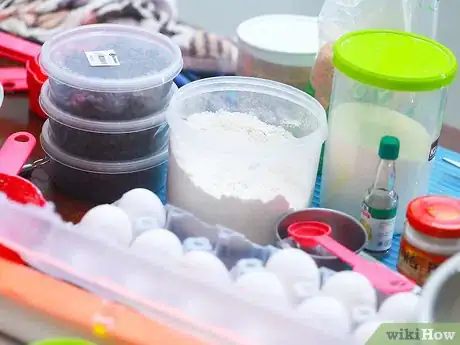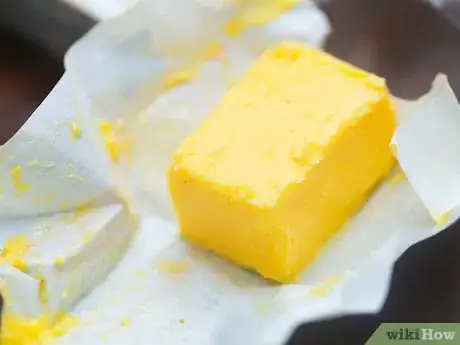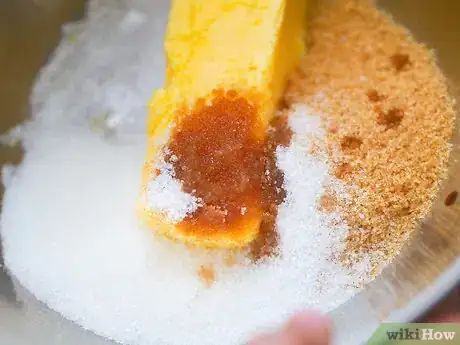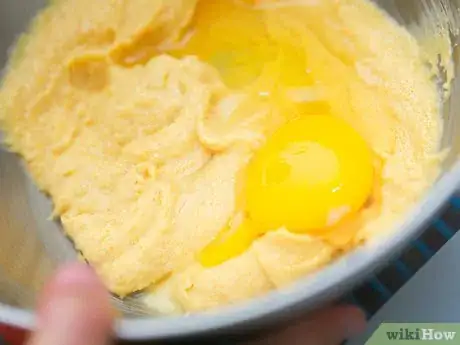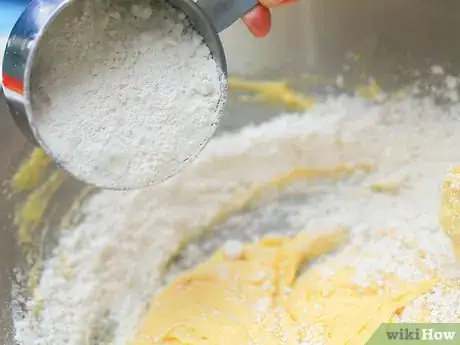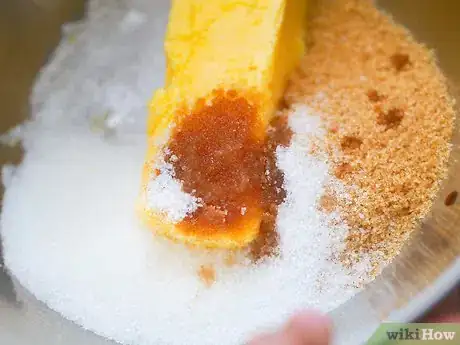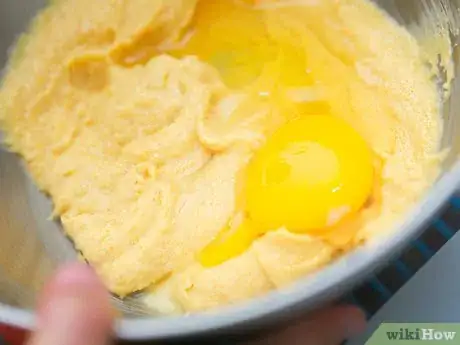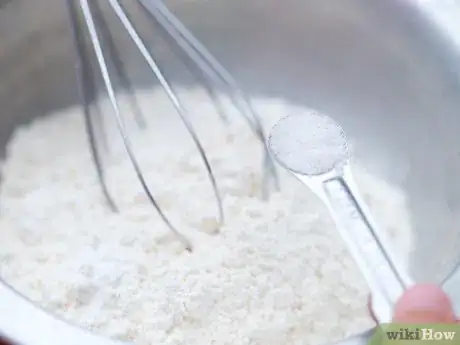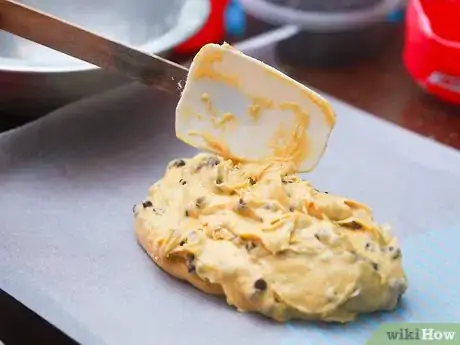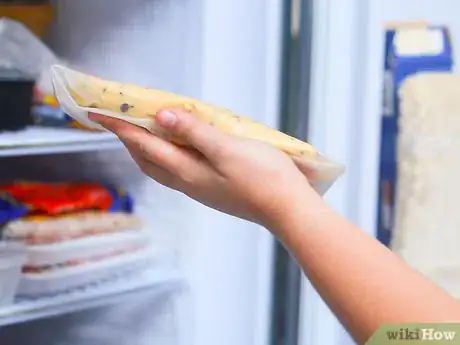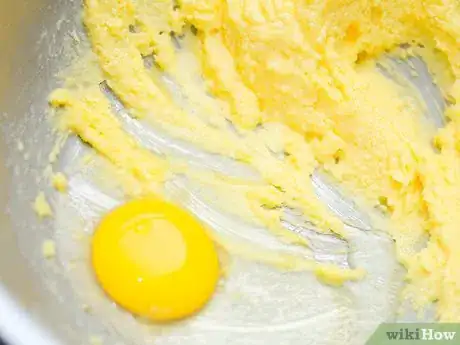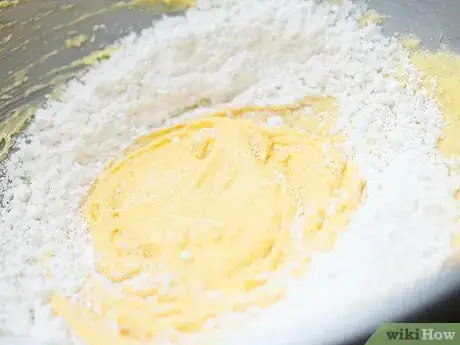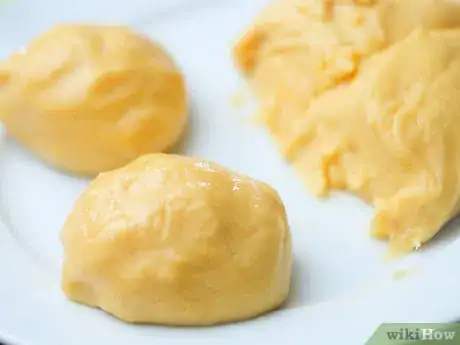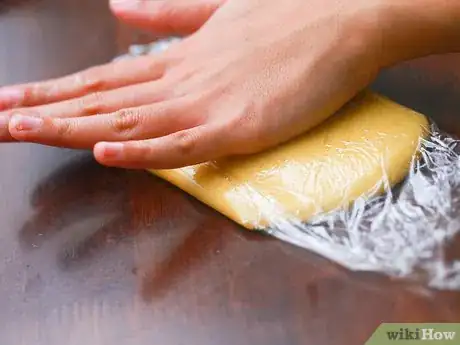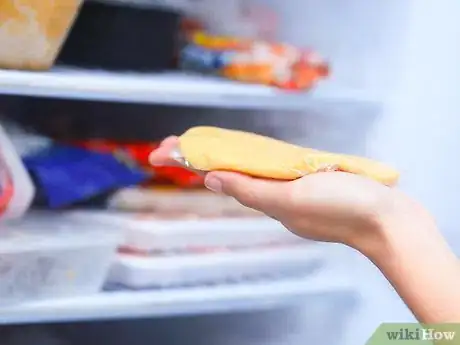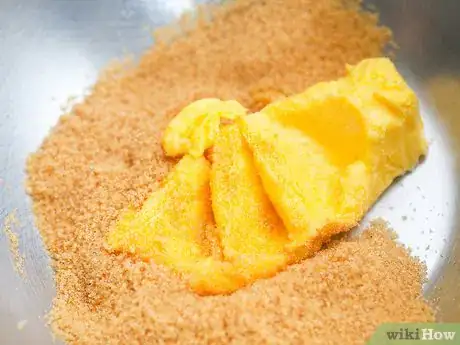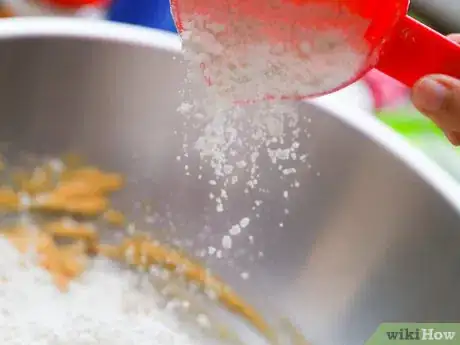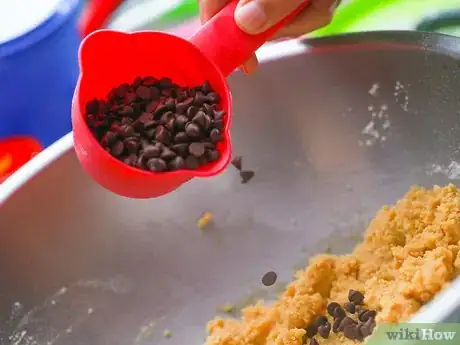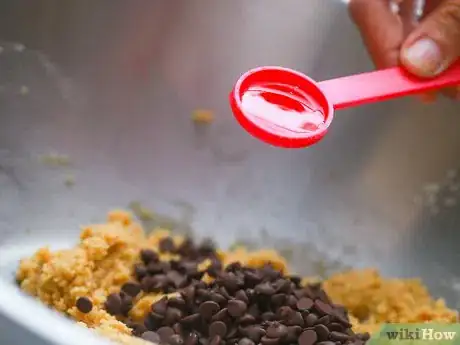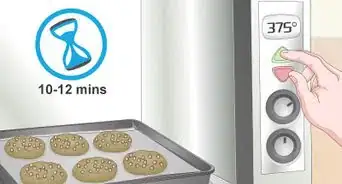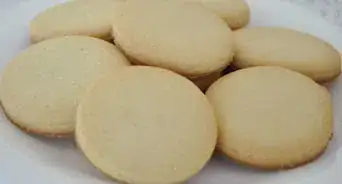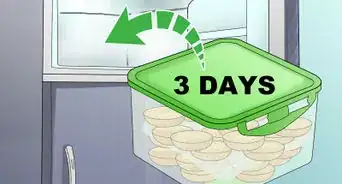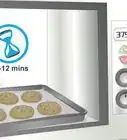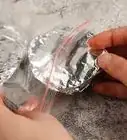wikiHow is a “wiki,” similar to Wikipedia, which means that many of our articles are co-written by multiple authors. To create this article, volunteer authors worked to edit and improve it over time.
This article has been viewed 61,639 times.
Learn more...
Every cookie recipe varies slightly, but there are common ingredients found in most recipes and a standard practice you should follow when making cookie dough. Additionally, most cookie dough can be refrigerated and save for at least a week after you make it. To learn more about the proper way to make cookie dough, and to view a few popular cookie dough examines, continue reading.
Ingredients
Makes enough dough for 30 cookies
- 1 cup and 2 Tbsp (280 ml) all-purpose flour
- 1/2 tsp (2.5 ml) baking soda
- 1/2 tsp (2.5 ml) salt
- 1 cup (250 ml) butter, or 1 stick, softened
- 6 Tbsp (90 ml) granulated sugar
- 6 Tbsp (90 ml) packed brown sugar
- 1/2 tsp (2.5 ml) vanilla extract
- 1 large egg
- 1 cup (250 ml) semi-sweet chocolate chips
Makes enough dough for 3 to 4 dozen cookies
- 1 cup (250 ml) unsalted butter, or 2 sticks, softened
- 1 cup (250 ml) granulated sugar
- 1 large egg
- 1 Tbsp (15 ml) vanilla extract
- 1 tsp (5 ml) salt
- 2.5 cups (625 ml) all-purpose flour
Makes 2 cups (500 ml) cookie dough
- 1/2 cup (125 ml) butter, softened
- 3/4 cup (90 ml) light brown sugar, packed
- 1 cup (250 ml) all-purpose flour
- 1/4 tsp (1.25 ml) salt
- 2 tsp (10 ml) vanilla extract
- 1 cup (250 ml) semisweet chocolate chips
- Water, as needed
Steps
Standard Cookie Dough Preparation[1]
-
1Review the ingredients. Every cookie dough recipe is a little different, so you should carefully review the specific recipe before proceeding. That said, most cookie dough recipes share the same basic ingredients in various proportions.
- Use the following guidelines to prepare cookie dough if you have a list of ingredients but lost the instructions that go with it.
- Most cookie dough recipes use some type of fat, sugar, eggs, and flour. Salt and baking powder are not used as consistently but do appear in many cookie dough recipes as leavening agents.
- Butter is the most common fat used, but shortening is also used frequently. Butter creates crisper, thinner cookies, while shortening creates soft, cake-like cookies.
- Vanilla extract also appears in most cookie dough recipes.
- Note that ready-to-eat or safe-to-eat cookies doughs don't contain eggs.
-
2Soften the butter. For best results, cut the cold butter into pieces and allow it to sit out at room temperature up to 30 minutes.
- The butter should be soft enough for you to leave an indentation with your thumb. Do not let the butter melt, though.
- Softened butter and margarine are easier to combine with other ingredients.
- If running short on time, you can microwave the cold butter for 10-second intervals until softened.
- If using margarine instead of butter, make sure that the margarine contains 80 percent vegetable oil or more.
Advertisement -
3Beat the butter and shortening together. If your recipe calls for both butter and shortening, you should cream them together with an electric mixer until smooth.
- Even if your recipe only contains one or the other, you should still consider beating the fat with an electric mixture until smooth. Doing so removes any lumps and allows the fat to mix into the dough more effectively.
-
4Add the sugar, baking powder, and salt. Use an electric mixer to beat in the sugar, salt, and baking powder or baking soda. These ingredients should be completely combined with the fat.
- Cream these ingredients until the consistency and color both become lighter.
- This process creates air bubbles in the dough, thereby creating lighter cookies. Do not overbeat the dough, though, especially at this stage.
-
5Add the eggs and vanilla extract. Use an electric mixer to beat the eggs in one at a time on medium speed. Add the vanilla extract simultaneously or immediately after.
- Beat until you remove all streaks of egg or extract.
- Consider leaving the eggs out at room temperature for 30 minutes before use. This makes it easier for the eggs to incorporate air in the batter, which creates lighter cookies.
-
6Gradually add the flour. Use an electric mixer to beat in as much flour as possible, adding it slowly to the dough. When the mixer begins to strain, switch to a wooden spoon and stir the remaining flour into the dough that way.
- Stand mixers can usually take the strain, so you may not need to do any stirring if using one. Hand-held mixers are less durable, though, and should be swapped out toward the end to prevent the mixer from burning out completely.
- Any chocolate chips, nuts, or similar ingredients should be stirred in after the flour.
-
7Save or bake as directed. Saving instructions and baking instructions vary, so it is best to find instructions that are specific to your recipe.
- Generally, you can wrap your dough tightly in plastic wrap and save it in the refrigerator for a week.
- Many cookie recipes bake around 350 degrees Fahrenheit (180 degrees Celsius) for 8 to 15 minutes.
Chocolate Chip Cookie Dough[2]
-
1Combine the butter, sugar, and vanilla extract. Cream together the butter, granulated sugar, brown sugar, and vanilla extract in a large bowl using an electric mixer.
- The butter must be softened before you combine it with the other ingredients. For a lighter dough, beat the butter on its own until it becomes fluffy before combining it with sugars and vanilla extract.
-
2Mix in the egg. Add the egg to the butter mixture and beat at medium speed with an electric mixer.
- Continue beating until the egg is fully incorporated.
- If doubling or tripling the recipe, add any additional eggs one at a time, beating well after each addition.
-
3Combine the flour, baking soda, and salt. In a separate small bowl, mix the flour, baking soda, and salt until thoroughly combined.
- Mixing the dry ingredients separately ensures that they are distributed evenly throughout the dough once added to the moist ingredients.
-
4Add the dry ingredients to the butter mixture. Use an electric mixture to beat the flour mixture into the butter mixture until completely combined.
- If the electric mixer resists toward the end of the mixing process, stir any remaining flour in by hand.
-
5Stir in chocolate chips. Use a mixing spoon or spatula to stir the chocolate chips into the dough until evenly distributed.
-
6Wrap the dough in wax paper. If you plan to save the dough for later, wrap it in wax paper or plastic wrap first. Make sure that no portion of the dough is exposed to air.
- Consider double-wrapping the dough. Wrap it in wax paper first, then wrap a layer of plastic wrap around the entire thing.
- To make the dough easier to manage later on, divide it in half before wrapping it.
-
7Refrigerate or freeze the dough. The dough can last in the refrigerator for 1 week. When placed in the freezer, it should last for about 8 weeks.
-
8Bake when ready. The cookies should be baked at 375 degrees Fahrenheit (190 degrees Celsius) for 8 to 11 minutes.
- Thaw the dough to room temperature for best results.
- Place the dough onto a greased cookie sheet 1 Tbsp (15 ml) at a time, leaving roughly 2 inches (5 cm) of space in between each cookie.
- Bake in a preheated oven until golden brown.
- Cool on the baking sheet for 2 minutes before removing to a wire rack to finish cooling.
Sugar Cookie Dough[3]
-
1Cream together the butter and sugar. Beat the butter and sugar together in a large mixing bowl with an electric mixer at high speed until fluffy.
- This should take about 5 minutes.
- Make sure that the butter is softened before combining it with the sugar.
- For this recipe, it is not necessary to beat the butter by itself first.
- For this recipe, an electric mixer fitted with a paddle attachment works best. A standard mixer attachment may also be used, however.
-
2Add the egg, vanilla, and salt. Add these ingredients to the creamed butter mixture and beat with your electric mixer until thoroughly combined.
- If doubling the recipe, add each egg one at a time and beat well after each addition.
- Use a medium speed when adding these ingredients.
-
3Gradually add the flour. Thoroughly mix the flour into the moist ingredients in two or more batches.
- Use a low speed to prevent the flour from flying out as you mix it.
- Only mix until the flour has been incorporated. Do not overmix.
- If the mixer begins to slow and struggle, stir the rest of the flour in using a mixing spoon.
-
4Divide the dough into 2 to 4 portions. Each portion should be about equal in size.
- It may be easier to work with four portions later on, but two portions will also suffice.
-
5Wrap the dough in plastic wrap. Place each portion of dough on a sheet of plastic wrap. Flatten the dough into disks before wrapping it completely.
- Each portion of dough should be wrapped separately.
- Make sure that no air can touch the wrapped dough. If necessary, double-wrap the dough to secure it.
-
6Refrigerate or freeze. Refrigerate the dough up to 1 week. If you need the dough to last up to 4 weeks, you should freeze it, instead.
- Note that even if you plan to use the dough immediately, it should still be refrigerated 2 hours before baking.
-
7Bake when ready. Bake the cookies in an oven preheated to 350 degrees Fahrenheit (180 degrees Celsius) for 8 to 10 minutes or until slightly golden.
- If using frozen dough, wait until the dough has dropped down to refrigerated temperatures.
- Roll the dough out on a floured surface until it is about 1/2 inch (1.25 cm) thick. Cut into shapes and placed on greased cookie sheets to bake.
Eggless Chocolate Chip Cookie Dough[4]
-
1Cream the butter and sugar together. Use an electric mixer to beat the butter and sugar together at medium speed.
- The butter and sugar should be fluffy and well-combined.
- Make sure to use softened, room temperature butter when starting.
- Mix the ingredients in a medium bowl.
-
2Add the flour, salt, and vanilla. Add these ingredients to the butter mixture and stir with a mixing spoon until thoroughly combined.
- Add the vanilla and salt to taste. Since there are no eggs in this recipe, you can add these two ingredients slowly and taste after each addition. Stop once you achieve a flavor you enjoy.
-
3Stir in the chocolate chips. Add the chips to the dough and mix well with a mixing spoon until evenly distributed.
- At this point, the dough will still be fairly thick.
-
4Slowly add water to the dough. Add cold water to the dough 1 Tbsp (15 ml) at a time, stirring well after each addition to incorporate it.
- Continue adding water until the dough reaches standard dough consistency. If you plan to add the dough in chunks to ice cream or other desserts, use less water for a stiffer dough. For a dough you can enjoy by the spoonful, add more water.
-
5Enjoy now or save for later. Since this dough is eggless, it should be enjoyed raw and is best when served immediately.
- To save the dough, place it in a resealable glass or plastic container and refrigerate it for up to 1 week.
-
6Finished.
Community Q&A
-
QuestionCan I put shaved chocolate, mint, and marshmallows in it?
 Community AnswerYou can put anything you want in it, just remember that anything you put in it has a potential to melt or shrink in the baking process.
Community AnswerYou can put anything you want in it, just remember that anything you put in it has a potential to melt or shrink in the baking process. -
QuestionIf I do not own an electric mixer, can I still mix it by hand?
 Community AnswerYes, simply mix it thoroughly until it forms/sticks together and everything is well blended.
Community AnswerYes, simply mix it thoroughly until it forms/sticks together and everything is well blended. -
QuestionDo I add milk to the butter and sugar before mixing? Should the milk be liquid or powdered?
 Community AnswerCream the sugar and butter before adding liquid milk.
Community AnswerCream the sugar and butter before adding liquid milk.
Things You'll Need
- Kitchen knife
- Mixing bowl
- Electric mixer
- Spatula or scraper
- Wooden mixing spoon
- Plastic wrap
- Baking sheet
References
- ↑ http://www.bhg.com/recipes/desserts/cookies/how-to-make-cookie-dough/
- ↑ http://www.verybestbaking.com/recipes/18476/Original-NESTL%C3%89-TOLL-HOUSE-Chocolate-Chip-Cookies/detail.aspx
- ↑ http://www.marthastewart.com/335378/basic-sugar-cookie-dough
- ↑ http://willowbirdbaking.com/2011/03/20/three-safe-to-eat-cookie-doughs-chocolate-chip-sugar-and-cake-batter/
About This Article
To make chocolate chip cookie dough, beat the butter, sugar, vanilla, and egg with an electric mixer until they're fully incorporated. Next, combine the flour, baking soda, and salt in a separate bowl. Then, add this mixture to the batter, beat the ingredients until they're combined, and gently stir in the chocolate chips. If you aren't baking the cookies right away, wrap the dough in wax paper or plastic wrap. The dough will stay fresh in the fridge for 1 week or the freezer for up to 8 weeks. For tips on making sugar cookie dough, read on!
